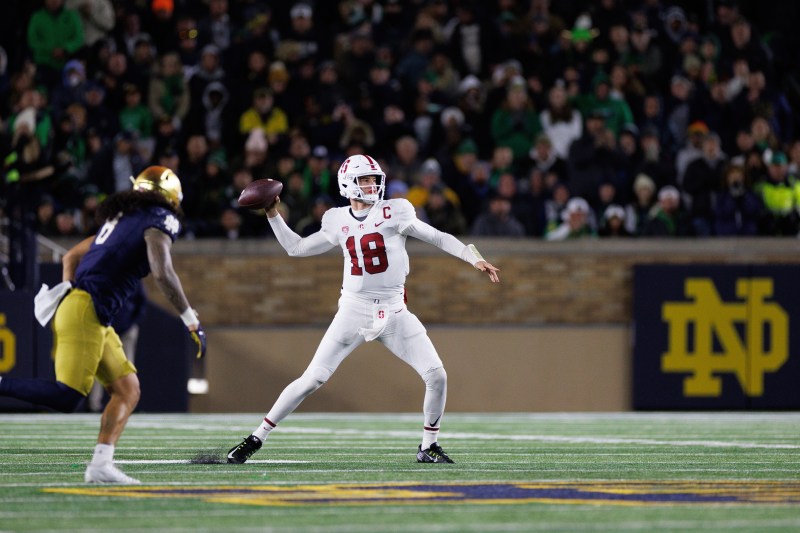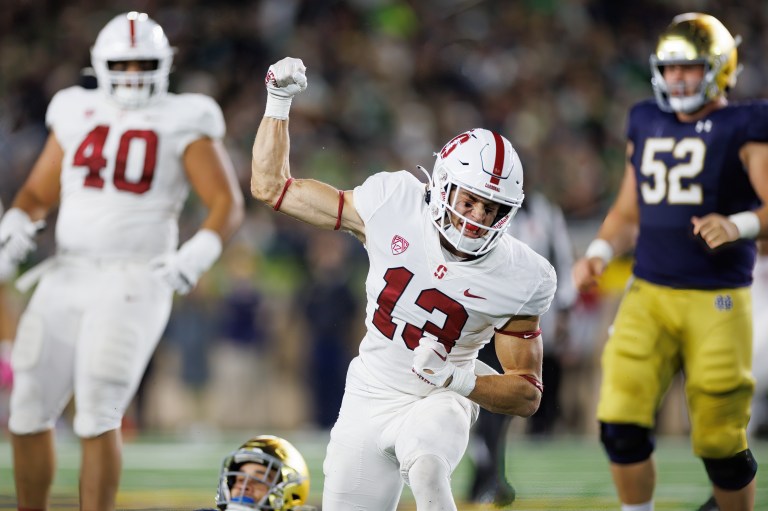Jubilation, vindication and relief — finally, after 11 games and over a calendar year removed from tasting FBS victory, Stanford football (2-4, 0-4 Pac-12) is back in the win column.
Few gave Stanford much of a chance entering Notre Dame Stadium, a venue where the Cardinal had previously only won four times in program history, as a three-score underdog. Fewer still would have imagined a winning scenario in which Stanford only scored 16 points. Yet, against the Fighting Irish (3-3), Stanford’s defense tuned out the noise and expunged the heartbreak from Oregon State (5-2, 2-2 Pac-12) in the most emphatic way possible, shutting down the Irish offense and producing timely turnovers.
The boisterous, capacity crowd was on its feet all game but never had the chance to truly make noise: indeed, the most striking sound in South Bend last Saturday was that of silence as fifth year safety Jonathan McGill broke up Notre Dame’s desperate fourth down pass to win the Legends Trophy for Stanford for the first time since 2017.
A win at Notre Dame is always special, and the timing of this one gives it the feeling of a potential turning point game. Equally important, though, Stanford built on the positives from its game against Oregon State, and perhaps there’s still some wind left in Cardinal sails as we enter the second half of the 2022 season with Saturday afternoon’s tangle with Arizona State (2-4, 1-2 Pac-12).
Riding this newfound momentum to victory against the Sun Devils is obviously paramount for Stanford. Plainly, Arizona State is a team that Stanford should beat. The Sun Devils, making the trip to Palo Alto for the first time since 2017, are a program in turmoil, rocked by an NCAA investigation into recruiting violations over the pandemic and a mass exodus of talent to the transfer portal last offseason. Controversial head coach Herman Edwards got the ax after an embarrassing home loss to Eastern Michigan earlier this year, and the Sun Devils slumped to 0-4 against FBS opposition to start the year.
Yet, as fate would have it, ASU enters Saturday with some swagger of their own, having upset a then-ranked Washington (5-2, 2-2 Pac-12) team in Tempe a fortnight ago before resting up with a bye last week. Saturday will make for an interesting matchup. In certain areas, the Sun Devils have glaring weaknesses in areas where the Cardinal can take advantage. With just four sacks on the year, the Arizona State defensive front is among the very worst in FBS at creating pressure, and the Sun Devils have suffered middling quarterback play all season. Yet, Arizona State has a solid rushing attack, and the Sun Devils’ secondary is among the best in the conference at forcing turnovers. Sloppiness from Stanford will be punished: the Cardinal need to start strong, as they have these last couple of games.
Fortunately, Arizona State resembles both Oregon State and Notre Dame with major questions under center. At the quarterback spot, the Sun Devils could feature either Florida transfer Emory Jones, who went down against Washington, or replacement Trenton Bourguet, who impressed in his first taste of collegiate action. Comparing the two, Jones has failed to impress but is a dual-threat; Bourguet is a traditional passer. Despite Bourguet’s hot hand, Jones is in line to start, but in any case, Stanford’s defense has looked much better these last two weeks against mediocre quarterbacks. Last week, the Cardinal defense held FBS opposition to under 20 points for the first time since a 2019 game at Colorado almost three years ago. The recipe for a repeat performance really is on last week’s tape.
Taking a step back, despite the season’s challenges, this is a game Stanford should win. ASU is a mess, ticking off games until some end-of-year introspection, and the Cardinal boast superior talent, home-field advantage and some newfound belief. Indeed, the betting markets back Stanford as a favorite in an FBS contest for the first time in 10 games, since Washington last year. That said, the Cardinal can ill-afford to come out flat and let the Sun Devils wrest control of proceedings. My guess is that 30 points should comfortably end Stanford’s wretched home run of just one win in the last 11 FBS outings on the Farm. But then again, Stanford hasn’t hit the 30 mark against FBS opposition in over a year, since last October’s visit to Washington State. One way or another, a home win is needed: the Cardinal should keep the following in mind to send folks home happy.
I. Get the ground game going — and get Casey Filkins some help
I know, I know. Stanford is not built to run the ball, and Cardinal fans want to see head coach David Shaw let Tanner McKee air it out. That said, the offense is predicated on at least some productivity in the run game, which has struggled in recent weeks, despite some solid performances from junior running back Casey Filkins.

Yes, some of this is injuries. Losing junior E.J. Smith, the team’s lead back, is obviously a big blow. Likewise, the rotating cast on the offensive line hurts the overall blocking scheme; starting tackles Myles Hinton and Walter Rouse are poised to start together for the first time in several games, which should help. Nevertheless, Filkins is a capable runner, but against Notre Dame, the run game was painful to watch. Filkins carried the ball 32 times but only tallied 91 yards, often facing a wall of Irish at the line of scrimmage.
The impact is obvious: time and time again, a run play would get stuffed and the Cardinal would fall behind schedule on a set of downs. Stanford doesn’t need the run game to be explosive, and it won’t be, but even modest improvement would go a long way in keeping the offense moving. And please, can Filkins get some help? In the four games since Smith’s injury, Filkins has carried the ball 92 times: all other backs combine for 12 carries and just 32 yards. Add in Filkins’ responsibilities receiving out of the backfield and returning punts, and the Oregonian is pulling a lot of weight: junior Caleb Robinson and sophomore Brendan Barrow need to step up too.
II. More of the same on D
Last week, the Cardinal took advantage of weak Notre Dame quarterback play to ground the Irish aerial attack, which in turn enabled the defense to get aggressive against the run. The approach worked to perfection, and Stanford played its best defensive game in years.
Digging in deeper, though, Stanford’s secondary underlied this success. We talked last week about stopping Notre Dame’s best weapon, tight end Michael Mayer. The Cardinal were excellent in this department, mixing coverages and double teaming him all afternoon. Then, senior cornerback Kyu Blu Kelly thrived on an island, taking away a perimeter option — it is hard to overstate how important Kelly is to the unit. As a result, Irish quarterback Drew Pyne regularly lacked options downfield, the passing attack was neutered and the Cardinal was able to devote bodies to sufficiently slow the run.
Coming into the year, this was exactly the blueprint for the Cardinal defense, and the recipe does not change this week. Arizona State’s passing attack, though not nearly as imbalanced as Notre Dame, is concentrated among a few contributors. Wide receiver Elijhah Badger, who ran for a 22-yard touchdown on a reverse in last year’s contest, is the distant number one for the Sun Devils, with over 70% more receptions than the next biggest contributor — his 29% target share is the second highest in the Pac-12. Expect Stanford to heavily hone in on shutting down Badger (whether that be through scheme or simply Kelly island) to try to force the Sun Devils away from the passing game towards a more one-dimensional offense.
III. Execute in short yardage situations
Stanford has an issue in short yardage situations. For years automatic in such scenarios, the Cardinal have struggled in this department all year. For perspective, Stanford has converted on just two of six 4th-and-1 or 2 situations this year, with one of those coming via penalty after a quarterback sneak was stuffed. And of course, there’s the 3rd-and-4 that would have put Oregon State to bed.

The Oregon State play — in which freshman dual-threat quarterback Ashton Daniels replaced Tanner McKee to run a read option — epitomizes Stanford’s short yardage struggles: the Cardinal lack an identity or a go-to play in these high-leverage situations. The Daniels play has not been reliable, the sneak bafflingly tends to get stopped (despite McKee’s 6-foot-6 frame) and the old “everybody knows it is a run up the gut, but who will stop it” power packages don’t get enough of a push. When Stanford got cute and threw a play action pass to the fullback last week, well, that failed too (albeit due to a blatant uncalled pass interference).
Will Saturday hinge on a key 4th-and-short? Hopefully not, but we’ll see Stanford need to convert one before the end of the year. Cardinal fans can only hold their breath — at the moment, these plays are recurring misadventures.
Pablo’s Picks of the Week
- Stanford 31, Arizona State 21
- Game I’ll be watching: No. 9 UCLA @ No. 10 Oregon
- Upset of the week: No. 17 Kansas State over No. 8 TCU
Pablo will be in the booth Saturday to call the game on KZSU.
